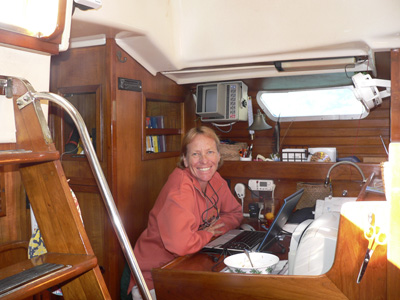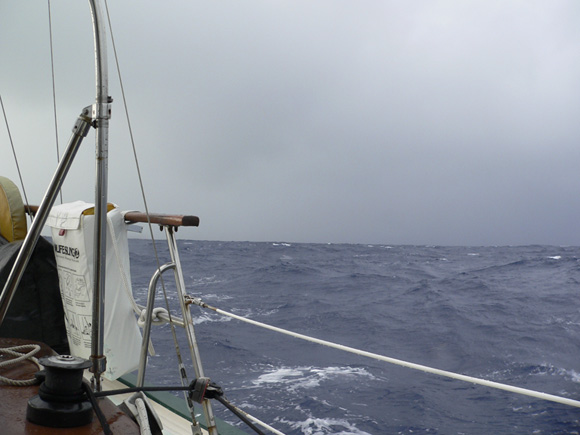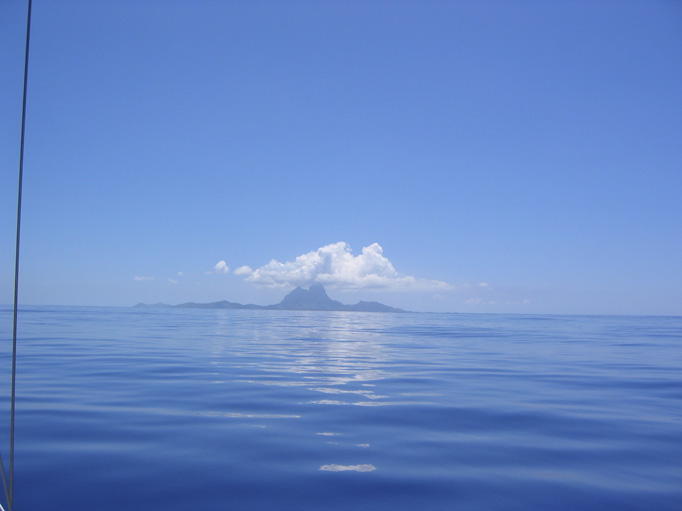Published in the Ocean Watch column, Honolulu Star-Advertiser © Susan Scott
April 14, 2014
AT SEA IN THE SOUTH PACIFIC » We’re sailing from Tahiti to Niue, a tiny island country of about 2,000 people.
Craig and I have been at sea on our 37-foot sailboat for more than a week now, sailing in brisk 20 to 25 mph southeast tradewinds. As Honu trundles along downwind toward Niue (we skipped the Cook Islands due to wind direction), we grip handholds for our every move, struggle to cook one-handed and joke about Robert Redford’s recent sailing movie, “All Is Lost.”
In that film, we long-distance sailors agree, all is lost about offshore sailing.
 Susan at the Navigation Station (desk) on Honu. In calm seas.
Susan at the Navigation Station (desk) on Honu. In calm seas.
Although that movie captured some of the challenges of open ocean voyaging, such as having to repair and improvise when things go wrong, the tale fell flat in its depiction of life on a sailboat at sea. Out here nothing is flat.
During our 1,200-mile passage, the southeast tradewinds have been blowing for days on end, good for covering distance but also the recipe for rough, rowdy waves. These great walls of blue water tumble over in sizzling white foam, smacking, rocking and rolling the boat with utter indifference. Riding on top of these noisy, towering hills can feel like a carnival ride from hell: It’s expensive, it make you sick and you can’t get off.
In most boating films, when people go inside the cabins, all there is calm and quiet. Craig and I laugh about that, too. You might get out of wind and rain below decks, but the motion of the ocean persists.

- The view from the cockpit of Honu, on the Coconut Milk Run 2006, during some rougher seas. Courtesy Scott Davis
As I write, I hold my laptop on the desk with the heels of both hands, moving fingers only, and my outstretched legs brace my body in my seat. The teak furniture down here squeaks and groans with the flexing of the Fiberglas hull, and the lines banging on the deck sound as if we’ve hit something. We’ve hit nothing. Craig and I take turns keeping 24-hour watch, but neither of us has seen a single man-made item. No boats, no ships and nothing floating on the surface.
From the reports of marine pollution, you might imagine Honu plowing through a sea of bobbing water bottles and foam cups. Not so. The ocean out here is a clean, sparkling desert of blue dunes marching over the horizon.
Like terrestrial deserts, marine deserts host animals, sparse and hard to spot but remarkable in their adaptability to a harsh environment. Several species meet here at the border of air and water.
From below, malolo (flying fish) burst up and skip astonishingly long distances over the surface, often plowing right through waves and popping out the other side.
Malolo are pupu for seabirds, the other creatures we see flitting between the waves in jerks like puppets on strings.
“Look,” one of us says, “a tropicbird (or booby or shearwater).” Because only one or two birds appear per day, a sighting is always worth a shout.
Weather forecasts are calling for declining winds, but even if it becomes glassy calm, the ocean will not be flat. Great smooth swells generated by distant storms will be rolling under Honu as we motor into Niue.
We’re looking forward to the change in sea state.
When it comes to sailing, it’s all about the ride.
 In glassy seas motoring Honu towards Bora, Bora, 2005.
In glassy seas motoring Honu towards Bora, Bora, 2005.
Courtesy Scott Davis